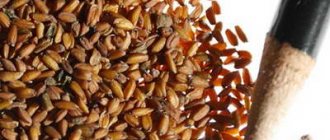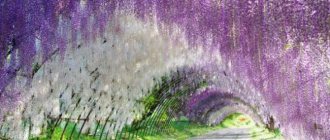Home Tips for summer residents
Ornamental cabbage looks more like an outlandish flower than a vegetable. Its heads of cabbage resemble roses, fancy lace or the feathers of magical birds. They bloom when other plants have already bloomed, which is why the crop is called the “queen of the autumn garden.”
- 2 Assol
- 3 Caprice
- 4 Peacock Red
- 5 Nagoya white
- 6 Lark's tongue
- 7 Coral Queen
- 8 Osaka
- 9 Kai and Gerda
- 10 Sunrise
- 11 Tokyo
Piglon
When you first see Piglon cabbage, you could easily mistake it for a rose bush. Ripe heads of cabbage have a pink-cream hue and resemble huge buds. They look very unusual in the garden.
The lower leaves are the same as white cabbage, but higher up the plant produces a beautiful flower. Its shapes are clear and round.
The crop requires sufficient moisture and fertilizer. She will decorate the area until frost.
Assol
The plant has a compact rosette with a diameter of about 45 cm. The height of the cabbage does not exceed 35 cm. The color in the center is yellow-white, green at the edges.
Assol is resistant to low temperatures, diseases and pests. The bud is quite lush, the leaves are wavy, the crop can decorate any front garden or flower bed. Flowering is especially spectacular in late autumn, when other plants have already faded.
Caprice
The variety is represented by rather low specimens, up to 50 cm in height. The bright crimson center is framed by dark green foliage. The edge is smooth, there is a waxy coating.
This species is even eaten. It is only necessary to first freeze the product before use to remove the bitterness. Unusual flowers are very beautiful and productive.
Peacock Red
The variety looks great in the autumn garden. A large rosette of serrated leaves that look like outlandish feathers will become a bright accent in a flowerbed or in a mixborder.
The variety tolerates low temperatures and high humidity well; moreover, it is with the onset of cold weather that the greens turn bright colors.
For the winter, the plant can be transplanted into a container, and it will remain decorative until the New Year. Peacock Red is ideal for single and group plantings.
Planting ornamental cabbage in open ground
Planting ornamental cabbage in open ground is undesirable while there is a risk of return spring frosts. Although ornamental cabbage can decorate your site until the first snow and frost, young plants are quite vulnerable. Typically, transplanting into soil or containers occurs in May.
As a permanent place of residence, it is better to choose a sunny area with loamy or sandy loam soil. In other conditions, ornamental cabbage will also take root well, but it will not look as impressive.
A handful of humus and wood ash are placed in the planting holes. You can add any mineral fertilizer for cruciferous vegetables - according to the instructions. In order to protect plants from cabbage flies, cruciferous flea beetles and excessively strong sun, some gardeners cover each seedling with half a plastic bottle, thus creating a mini-greenhouse. You can also use arcs and covering material or film.
Ornamental cabbage acquires an interesting shape and bright color as it grows - closer to autumn. If you plant such cabbage next to bulbous plants that do not require digging after flowering (for example, with certain varieties of tulips), then your flowerbed will be elegant all season.
Nagoya white
The Japanese hybrid is a low plant with a rounded head that looks like a large white bud with heavily corrugated edges. The stem is short, only 25-30 cm, the outer leaves are light green, the inner leaves are pure white.
With the onset of frost, the color of the rosette becomes even fresher and brighter.
Nagoya is frost-resistant, very hardy to adverse weather conditions, and unpretentious. Lush terry foliage looks like skillfully knitted lace.
Lark's tongue
The tall variety, reaching 130 cm, resembles both a Christmas tree and a palm tree. The spreading leaves on long petioles are colored in various shades of green. With the onset of cold weather they turn blue.
This exotic plant, like regular cabbage, loves moisture. Resistant to cold weather. Young curly leaves will serve as an excellent addition to any salad.
Description of the plant
If you plant seeds in a greenhouse or at home at the very beginning of spring, cabbage will “bloom” already in June-July. Or rather, it will take on a decorative appearance. But what it will be like depends on the variety.
There are so many of them, differing from each other in shape, height and color, that it is impossible to describe everything. But you can get an idea of this amazing plant by checking out the most popular species.
| Photo of the variety | Description |
Green curly | A palm-shaped plant reaching a height of 130 cm. On long petioles, up to 20 cm, there are large green leaves with a scalloped edge. |
Kai and Gerda | This is a mixture of plants about half a meter high with two shades of leaves - emerald and purple. |
Red curly | Palm-shaped ornamental cabbage with leaves of an unusual bluish-violet color. |
Nagoya | A powerful, low-growing plant, the rosette of which grows up to 60 cm in diameter. The leaves are fringed, white or red. |
Tokyo Pink | Low, up to 30 cm plants with bright central and dark green lower leaves with a wavy edge. |
Piglon | This variety is surprisingly similar to a rose flower. And the plants themselves, unlike many other species, are small, with slightly corrugated leaves of different colors. |
Osaka | This variety, like Tokyo, was bred by Japanese breeders. But it is larger and taller - up to 45 cm in diameter and up to 60 cm in height. Colors: white or dark pink. |
Coral Queen | This variety got its name thanks to its unusual bright red, heavily dissected leaves. From a distance, the plant can actually be mistaken for sea corals. |
These unique plants retain their decorative properties until the very frosts, as they are not afraid of low temperatures and can easily withstand frosts down to -10 degrees.
Advice. Cabbage easily tolerates transplantation, which allows you to plant it in a permanent place at any time. Since it reaches its maximum decorative value by August-September, it can be planted in a flowerbed instead of other flowers, which by this time have already faded.
Coral Queen
This decorative variety with expressive feather-like foliage will not leave anyone indifferent. The culture prefers sunny places, sufficient moisture, and easily tolerates slight cold snaps.
The height of the hybrid reaches 35 cm. Along the edge the foliage is green, in the middle of the rosette the color smoothly turns into bluish-red. The plant itself resembles an outlandish coral.
Kai and Gerda
The variety is a mixture of two varieties - with emerald green and dark purple leaves. The plants resemble small palm trees, 50-70 cm high, with strong openwork foliage.
The variety is frost-resistant, can withstand temperatures down to -15°C, and is unpretentious to growing conditions. Beautiful corrugated leaves not only decorate the flower garden, but are also used as food: they can be added to salads or vegetable soups.
Ornamental cabbage - growing and care
Ornamental cabbage needs weeding, loosening the soil and hilling (2-3 times per season), which promotes the formation of lateral roots and the retention of moisture in the soil. To ensure that the elegant head of the plant remains stable, experienced gardeners often sprinkle the cabbage with soil, leaving a small depression under the leaves (plant it in a hole), and add fertile soil as it grows.
Starting from June and until the end of the growing season, ornamental cabbage can be fed with complex fertilizers (according to the instructions) or mullein infusion.
If the land on which you grow ornamental cabbage was fertilized with manure, the leaves of the plant will be larger, but will largely lose their decorative effect, because green will be the predominant color.
Excessive application of nitrogen fertilizers reduces the resistance of seedlings to various diseases. At the same time, a balanced complex fertilizing (10 g of ammonium nitrate, 20 g of superphosphate and 10 g of potassium chloride per 10 liters of water), on the contrary, will help your plants resist blackleg and other diseases to which cabbage is prone.
Ornamental cabbage feels good and looks impressive in 10-15 liter pots
Sunrise
This plant can hardly even be called cabbage. Most of all, its soft cream buds resemble huge beautiful roses. Original bouquets are made from the inflorescences of the hybrid. It is used everywhere to decorate parks and gardens.
Sunrise is grown in sunny places. The decorative effect of flowers lasts for a long time.
They can also be used in cooking. The greens you like are carefully cut and used for making salads.
Where is it used and can it be eaten?
Ornamental cabbage is used in landscape design.
It can be planted:
- as part of compositions with flower plants - they form a contrasting spot against the background of other flowers and tall plants;
- as living borders - planted along paths and enclosing flower beds;
- in flowerpots and hanging flower pots – you can grow both individual plants and groups;
- as a single plant - completely plant the space with only ornamental cabbage;
- as part of compositions from different varieties - creating multi-colored patterns;
- in alpine slides - you can use both high and low varieties.
You can create original bouquets from Brassica. To do this, it is cut off at the root and placed in a vase with a small amount of water. To make the bouquet last longer, add a few crystals of potassium permanganate or 1 tsp to the water. sugar and a pinch of salt per 1 liter of water. Change the water 2 times a week, and the bouquet will last about a month.
In floristry, decorative cabbage is used to create vegetable bouquets.
Most often, ornamental cabbage was grown as a fodder plant, but it is quite edible, like cabbage or cauliflower. The leaves are rich in vitamins and can be a good source of them in winter.
A peculiarity of ornamental cabbage is that the leaves lose their bitter taste after the first frost.
Tokyo
This decorative species is used to decorate flower beds, flower beds, and recreation areas. A dense, lush rosette, consisting of 30-40 rounded leaves, can be soft white, red or pink-raspberry. With the first frosts the color becomes even brighter.
The variety is resistant to cold, stress, bad weather, and is not susceptible to infections. Having transplanted the bushes into flowerpots, you can admire the flowering until mid-winter.
- Author: Inna Kiseleva
Rate this article:
- 5
- 4
- 3
- 2
- 1
(1 vote, average: 5 out of 5)
Share with your friends!
Options for use in landscape design
It is not for nothing that ornamental cabbage is often called a flower; its beauty and variety of colors and shapes can, without exaggeration, be compared with the recognized queen of flowers - the rose. But the exotic vegetable flower has an advantage - cabbage is also tasty and healthy. And its flowering only becomes more colorful and brighter in cold weather. It looks great and regal in any composition. And here are examples of this.
Decorative cabbage in flower beds
When planting in a flowerbed, the following options are possible:
- By alternating white and colored heads in a checkerboard pattern, you can get a surprisingly colorful chessboard.
- Plants of the same species, but of different colors (this is observed in Nagoya or Osaka hybrids), planted in the form of a huge flower or geometric figure, will resemble an English classical garden.
- By placing tall specimens in the center of the flower garden, framed by lacy, low-growing species, you can give it volume. The effect will be enhanced by a play of colors with alternating dark and light stripes.
- A good option is to zone areas with decorative bushes that form different shapes, each in its own color scheme.
- Non-standard flower beds look original in the form of baskets of flowers, carts, barrels or even an impromptu truck filled with bright bouquets of cabbage flowers.
Also read: Technology for proper care of gladioli in autumn
A good option is zoning areas with decorative cauliflower bushes.
Container growing of ornamental cabbage
This option is convenient because when cold weather sets in, you can move the compositions to the terrace, winter garden or glazed balcony. Several options for this method of decorating a site:
- Fence a resting place or path with cabbage tubs and place them symmetrically next to the bench.
- You can build a large colorful pyramid from special containers. Moreover, to make it look like a favorite children’s toy, plant cabbage “rings” of contrasting colors at different levels.
- A simple but impressive-looking solution: planting three contrasting colors of plants against the background of lawn grass in a large flowerpot.
The container growing option is convenient because when cold weather sets in, you can move the compositions to the terrace
Joint planting with other plants
Cabbage flowers get along well with other plants in diverse compositions:
- Miniature gardens in containers with herbs and St. John's wort, and dark varieties of cabbage look good against their golden-green background.
- Climbing plants and species with small leaves and flowers, such as begonia, are good neighbors. This picture resembles an outlandish carpet with a large pattern in the middle.
- Against the background of a solid wall of climbing ivy or wild grapes that change color seasonally, flowers made from cabbage of different colors look advantageous.
- Pink flowers can be planted in groups of three, shading them with summer flowers, and on the far line with low bushes. It is better to plant cabbage roses in purple or green shades, and the flowers should be orange or yellow.
- Alpine hills look great, where fesalis and marigolds are present in company with ornamental cabbage.
Cabbage flowers get along well with other plants in diverse compositions











